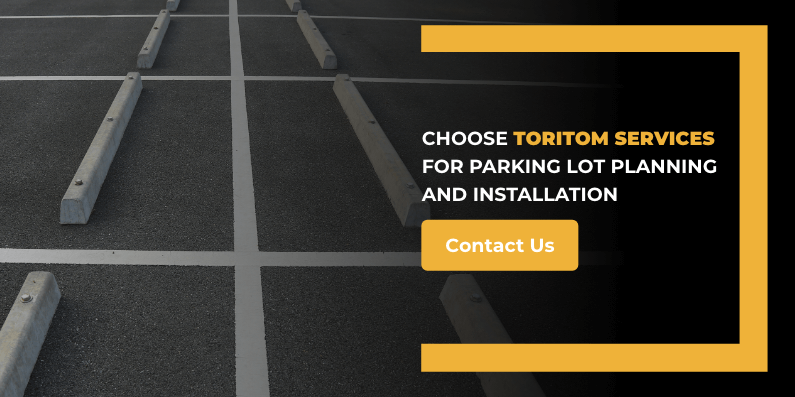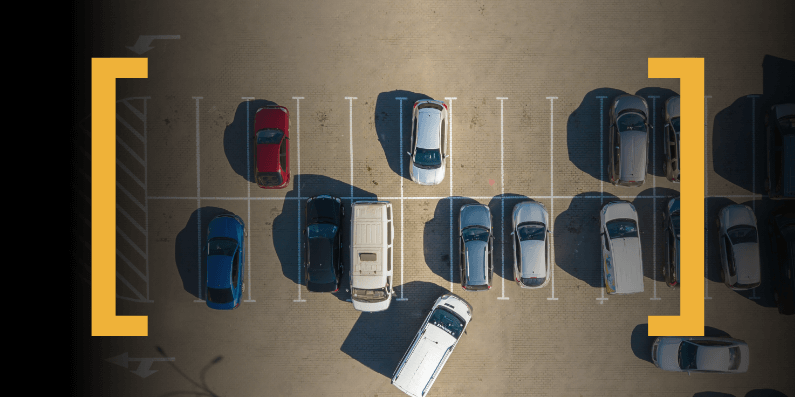
Parking lots are often the first spaces customers interact with at many facilities and businesses, influencing their impressions and experiences. Property owners can implement parking lot design elements that support motorists and pedestrians to ensure a positive association with their properties. Learn more about parking lot design planning below.
Parking Lot Design Standards
When designing parking lots for your commercial properties, you must determine what parking lot dimensions and features you need, particularly in accordance with specific building guidelines. Following these standards ensures you stay compliant with your local and state governments and makes planning your parking lot easier.
Parking Space Angles
The angle of the parking spaces can impact the overall layout and space. Possible options include 30°, 45°, 60° and 90° angles. The decision will come down to offering either angled parking spaces or perpendicular spaces or a combination of both, which will depend on the kind of parking lot you need to construct.
Angled parking spots have some considerations you should understand before implementing them. Because angled spaces need to face incoming traffic, it can be challenging to design two-way lanes when using them. Further, the angle means drivers can’t align their vehicles with those beside them, increasing the risk that cars stick out into lanes.
Still, including angled parking offers many benefits to drivers, including:
- Simplifying parking: Angled parking spaces are easier to navigate. When designers angle them toward incoming traffic, drivers can quickly pull into spaces. When it’s time to leave, the angle helps them avoid other vehicles and reenter lanes easily.
- Optimizing space: When you have a smaller lot, angled spots can help you fit more spaces to meet your quota. Angled slots create narrower aisles because motorists need less space to park. You can provide more aisles with available spots for a parking lot layout that better meets your needs.
- Matching your needs: These spaces are great if you have a high turnover rate. Commercial settings often have many visitors coming and going throughout the day, so angled parking spaces and their parking ease can support this function. With more space efficiency, you can delegate space to other essential features, like shopping cart racks or checkpoints.
Your other option is 90° angled spaces, also called perpendicular and straight parking spots. Perpendicular spaces are harder to navigate, making them ideal for places with less turnover, like residential or airport parking. They’re less space efficient than other options because they require more parking space, creating wider lanes.
Like angled parking, they have several advantages, including:
- Increasing accessibility: These lanes are straight, meaning drivers can approach and use them from any direction. This angle option can increase your parking lot’s flow and decrease traffic. Drivers can even pull through to other lanes if you forgo concrete barriers.
- Ensuring two-lane traffic: This angle type requires wider angles so that drivers can park, allowing you to use two-way lanes. When you want to optimize flow and layout, this angle option makes it easy for drivers to navigate the lot.
- Securing aisle space: Because motorists will park directly next to others, they can line up their vehicles with those beside them. This ability helps ensure cars are within spots and not sticking out into lanes, reducing the risk of parked vehicles getting scratched or dented by oncoming traffic.
Parking Space Proportions
Parking lot design standards outline typical parking lot proportions based on the angle and lane number you use. The standard measurement for spaces is 9 feet by 19 feet. The aisle proportions will depend on which angle you implement and how many lanes you use:
- 30° proportions: 30° angles create 12-foot aisles. Including your parking spaces, this option will take up 28.8 feet for single lanes and 45.6 feet for double lanes. Because this is the narrowest angle, it offers the smallest dimensions.
- 45° proportions: 45° angles only use slightly larger aisles, measuring 12.1 feet. In total, you’ll need 31.1 feet for one-way layouts and 50 feet for two lanes.
- 60° proportions: This parking angle requires 14.5-foot aisles. The dimensions for 60° angles are 34.6 feet for single-lane traffic and 54.7 feet for double-lane traffic.
- 90° proportions: Perpendicular spaces use the most space, so your proportions will be the largest if you choose this angle. The lanes will measure 24 feet. Single lanes require 42 feet of space, while double lanes need 60 feet.
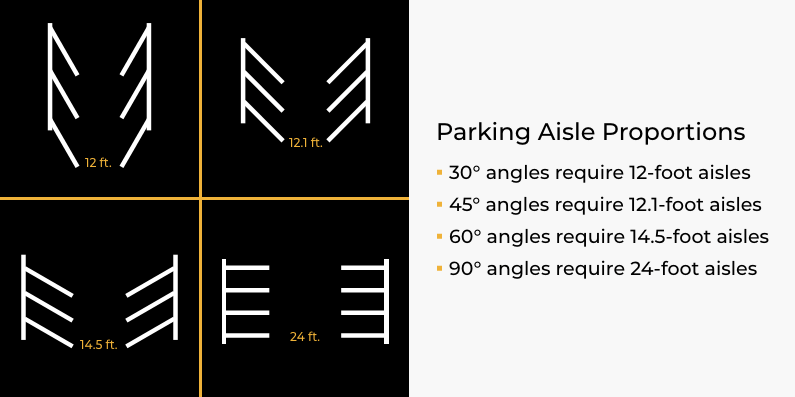
Understanding the space required for each angle can help you better plan parking lots based on your available space and preferred parking angles. When painting lines for parking spaces, the lines should be 4 inches thick and colored white, so visitors can see space parameters and park properly.
Drainage
To ensure parking lot quality and safety, you must install adequate drainage systems. Because drainage systems will go below the pavement, plan for and implement these considerations early in your parking lot design process. The drainage systems will function with two goals — to preserve the lot’s quality and direct water away from natural sources.
A sound drainage system will prevent flooding in your parking lot. Flooding can make it challenging for motorists to navigate your parking lot when it rains, and sitting water can seep into your asphalt and cause cracks or weaken your subgrade materials. Potholes and unstable sections will add maintenance costs and increase risks for parking lot visitors.
Consider implementing a slight slope to naturally guide water away from busy throughways and toward the drains. A slope between 2% and 5% is best to ensure parking lot stability and efficient drainage. You can also give the gutters a grade of 0.5% to help guide water at a speed that prevents flooding around the drain entrance.
Because water from pavement might mix with grease and oil from parked vehicles, the gutters should drain to specialized facilities and away from springs, wells and waterways. Following these guidelines can protect water supply integrity while preserving natural ecosystems. You should have systems to direct groundwater that soaks through the pavement and subgrade materials to facilities.
Accessibility Standards
The Americans with Disabilities Act (ADA) outlines accessibility compliance requirements for parking lots. Your lot’s size and spaces will determine how many disability parking slots you must legally include. The ADA factsheet breaks down the number of spaces you’ll need depending on how many you have. For example, a parking lot with 100 spaces must have at least four accessible spaces, while a 500-space lot will need nine. These spots should be at the front of your parking lot, close to facilities and ramps for the easiest access.
The ADA also requires that a portion of these accessible spaces be van-accessible. For every six disability spots, one of them needs to be van-accessible. If you need nine accessible spaces in your 500-slot lot, two must be van-accessible. These spaces ensure people who use wheelchairs have enough room to exit and enter their vehicles when using your parking lot.
Van-accessible parking spaces need to be bigger than common spaces at 11 feet wide. These spaces also need access aisles next to them for increased room and should be 5 feet wide. You can place these aisles between two van-accessible spots for optimized space efficiency and should mark them with dashed lines to indicate vehicles can’t park there.
All disability and van-accessible spaces require visual markings for motorists and parking enforcement teams. Signs should stand around 5 feet tall, so motorists can see them from their vehicles. Painted symbols at the end of parking spaces can also convey essential information about space availability to visitors.
While parking spaces have many requirements, you should apply accessibility initiatives to every part of your parking lot. If you have curbs, allow people with mobility aids to better access pedestrian areas and walkways by installing ramps. Even parents with younger children can benefit from these features, as it’ll be easier to push strollers through your parking lot.
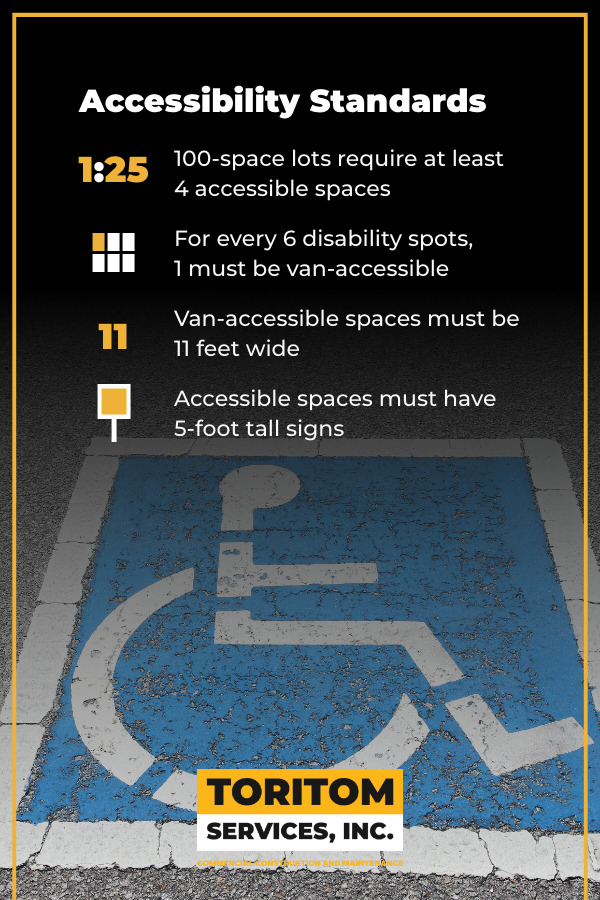
How to Design a Parking Lot
Once you know what standards and regulations to consider, you can start designing your parking lot.
1. Evaluate the Parking Lot’s Purpose
Your parking lot’s purpose will determine many aspects of planning and designing. Whether you own a strip mall or a grocery store, your parking lot design must support its function. Some elements that will reflect the lot’s purpose include:
- Parking angle: The angle you use should reflect your lot’s purpose. For example, perpendicular spaces are more challenging to navigate, making them less ideal for grocery stores or commercial locations where visitors will spend little time on your property. Parking angles can make or break the experience for customers on your properties.
- Pavement thickness: The pavement thickness will need to support your traffic. While cars can handle thinner pavement, warehouses and bus lots need thicker asphalt to accommodate heavier vehicles carrying large loads.
- Zones: Depending on your property, it might have multiple functions. For example, a hardware store parking lot will need to function for customers coming to shop and trucks delivering products. A fast food restaurant might have a drive-thru alongside its regular parking. Consider the various zones of your property when planning the lot.
- Accessories: Your parking lot might need additional signage and features depending on its function. An apartment complex or government building might use barriers at the entrance to block entry to anyone who isn’t approved to enter. Think about the additional features your parking lot might need.
Identifying your parking lot’s purpose can ensure you best meet tenant and customer expectations and needs on your properties.
2. Plan Traffic Flow
Your parking lot’s layout can impact traffic flow. You’ll want a straightforward structure to optimize flow, allowing visitors to search for spots easily and have a more positive experience in your lot. Flow can also impact safety. When parking lots are easy to navigate, drivers can better assess their surroundings and be aware of pedestrians and other vehicles.
Parking lot designers and property managers have many options to optimize their traffic flow and layout, including:
- Two-lane traffic: Visitors can better navigate your parking lot with two-way lanes. With this setup, motorists can explore spaces on both sides of the road and always ensure they’re moving with traffic, preventing confusion and frustration. If you want to use two-way lanes with angled parking, ensure you point spaces toward incoming traffic for easy parking.
- Signs: Signs can help direct motorists within and around your parking lot. Painted directions can cue drivers on which direction to turn and navigate them toward exits. Stop signs can mark problem spots and determine the right of way, preventing accidents and controlling speed. To maintain safety, you can also place signs on the roads leading to the entrance and around your property.
- Connectivity: When laying out your parking lot, you can maximize flow by creating connecting lanes. Dead ends and confusing turns can add to frustration or cause motorists to make poor decisions. Adjoining areas can help drivers find spots easier because they can better change aisles.
When you want to create a parking lot that meets user needs, flow can help. The lane choice and layout of your parking lot can ensure better parking and movement, so motorists can find spots and exit safely.
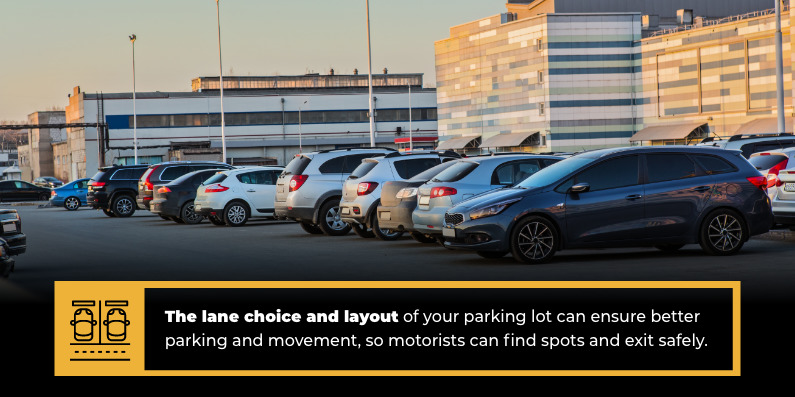
3. Address Safety Concerns
Your parking lot design can boost safety on your property. With the right elements and features, you can better protect your tenants and their customers on your property:
- Lighting: Adequate lighting is essential for functionality and safety. By installing proper lighting, you can increase how long your property is open. Lighting also helps ensure visitors can get safely to their cars and drive carefully without damaging other vehicles. Well-lit public areas can help decrease criminal activity — one study found crime dropped by 36% in areas with more light. At the same time, consider light density to reduce glare and light pollution.
- Accessibility: You can better protect your property and parking spaces by limiting who can access them. Barriers and gates ensure only employees can enter a specific section of parking spaces, making them more secure and keeping their cars safe. You can even equip checkpoints with security guards who can check IDs and passes.
- Pedestrian needs: Your lot’s features and design can keep pedestrians safe walking across your property. If they need to cross your lot to get somewhere, include crosswalks marked by signs and painted lines. The lanes within your lot should be wide enough for cars and pedestrians to move safely. Signs can help direct foot traffic to areas dedicated to walking, so they’re safely out of the way of vehicles.
- Barriers: Concrete parking barriers are a great way to keep vehicles safe. They can help motorists line up their cars in spots, increasing their chances of being in the lines. Well-parked vehicles can reduce the risk of scratches and dents when parking. If your property is located in a residential area, you can also use barriers to block sound and light coming from your lot, building stronger relationships with your neighboring properties and communities.
Choose ToriTom Services for Parking Lot Planning and Installation
Designing a parking lot is a comprehensive process that involves many steps and considerations. Partnering with the right parking lot service can help you manage each process for better results. ToriTom Services offers several options to commercial property managers and maintenance teams for superior commercial parking lot installation.
We can install asphalt pavement for dependable parking lots and apply a seal coat for increased protection and durability. Our lot striping service can help improve flow and visibility by using the right colors and symbols to match your lot’s needs. Further, our highly-trained employees understand ADA compliance standards, ensuring you create a lot that’s accessible to all visitors.
Contact ToriTom Service today and discover how we can help you design a parking lot for your properties.

